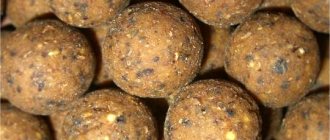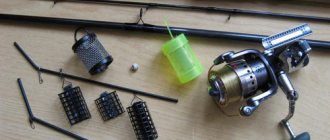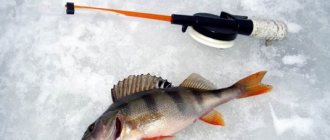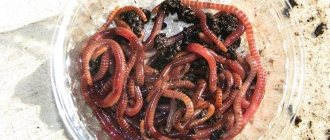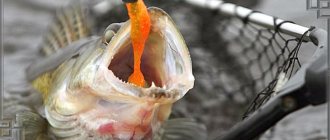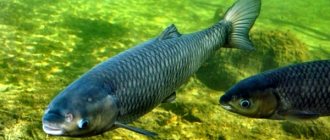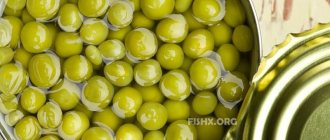Habitats
Crawling Catching Crawling Crawling
is found in almost all types of soil and, depending on its habitat, can change color. White specimens that live in clay soils are more durable and durable. For fishermen they are of particular value. Worms live in the ground at a depth of up to two meters, and mainly rise to the surface only at night or after rains. At low atmospheric pressure, they can often be found on the surface in the most unexpected places.
How to catch crawlies
Hunting for crawlies is no less exciting than fishing itself. This activity requires even more dexterity, dexterity, caution and patience than fishing. Quite often it lasts almost until the morning, especially during the summer heat. On hot days, crawlers go deep into the ground and may not appear on the surface at all, even at night. Rainy weather is a completely different matter. If it rained well during the day, these worms will definitely show themselves when darkness falls. You can also try to lure them out. For example, pour several large buckets of water over loose soil somewhere in the garden. The crawlers will sense the moisture and immediately be drawn to it. It is important that there is no vegetation in the artificially moistened area, as it will greatly interfere. It is much more difficult to catch a worm in the grass.
Another difficulty lies in the fact that the crawlers almost never crawl out completely. They leave a tail in the hole and, at the slightest danger, “dive” into the ground at the speed of a bullet. This means that you need to behave with extreme caution. When the flashlight beam snatches the thin body of the worm from the crown of the head, the light must be dimmed immediately - taken a little to the side. Next, you need to try to approach silently (the crawlers feel the vibration of the soil), bend down quietly and press the worm to the ground with the fingers of your free hand. At this crucial moment, you should use all your restraint and not give in to the temptation to pull it out right away. Many are in a hurry and begin to pull, which is why the crawl simply breaks and one half of it remains in the hole. This cannot be allowed. Let it resist, strain and lose strength, and when it weakens (after about 30 seconds), then you can begin to slowly remove it from the ground. This is the only way the worm will remain safe and sound, that is, alive and suitable for fishing.
To be sure to catch crawlers, you need to use a light source that is not too bright and wear soft shoes that do not create noise when walking. By the way, many modern flashlights have a diffused light mode. Everything else is a matter of technique. After a couple of torn worms, you will understand how to get them out correctly.
Extraction methods
Unlike worms, crawlers are not dug, but caught. You can catch it in the countryside at night. Although the crawler is not a fish, there are the most favorable conditions for catching it. The most successful hunting for it will be days with low atmospheric pressure, even better if it rained the day before.
Already half an hour after sunset you can start catching these worms. Having illuminated the ground with a flashlight, you will see them crawling out of their shelter holes. Crawlers rarely leave their burrows completely; they usually crawl out to the length of their body. Its back always remains in the ground, allowing it to quickly go into the ground in case of danger. Remember that crawlers are sensitive to any vibrations in the soil, so you can’t stomp, you need to move carefully.
We saw a worm lying down. If the flashlight does not have a red filter, we try to shine it not on the worm, but slightly to the side. We sharply grab the crawler in the place closest to the mink in order to intercept it and prevent it from hiding. Once you try it, you'll immediately realize how fast this worm is! They grabbed me. Some part of the worm managed to hide. Don't pull, otherwise we'll tear it. Let's keep it. The worm contracts, after a couple of seconds we hear weakening and manage to pull the worm out. So we go and catch.
How to breed crawlies
Crawlers are bred in voluminous wooden boxes. They are, of course, inferior in durability to plastic containers, especially due to dampness, but they are more natural for worms, which live and reproduce better in them than in plastic buckets and boxes. Sand is poured onto the bottom of the box as drainage to remove excess water, and soil is placed on top, preferably the one in which the collected worms lived. The top of the box is closed with a lid with holes. A metal mesh with a fine mesh is often installed. Ground vegetables, boiled potatoes, and cabbage are used as top dressing. Bran is also added. In the summer, leaves will also appear. From time to time you need to throw a little crushed eggshell or a little lime into the crawl box to extinguish the resulting excess acidity of the earth. In addition, you need to ensure that the soil is not dry or overly wet.
The most suitable place for breeding crawlers is the cellar. You can also use a garage for storing and breeding worms, but the place for the box should be dark, since, as we know, these worms feel more comfortable in the dark. And when fishing, you should try to keep the crawlers in a wooden box or in a bag made of tarpaulin or durable fabric.
I recommend to read:
How to store worms
Share with your friends!
Breeding crawlies
You can set up a permanent worm nursery in a village or country house. Somewhere behind buildings in the shade or under a straw shelter, they dig a hole up to 1 m deep, which is half filled with last year's half-rotted manure, garden soil is added, and then from time to time kitchen waste is dumped there and soapy water is drained. Worms are thrown into this pit for breeding, which will produce several generations over the summer.
Properly prepared dense compost creates a living environment for worms. When caring for it, you can breed worms in winter. Using compost is a particularly practical way to obtain worms in dry areas.
To keep the compost moist even in hot weather, they do it this way. The place is chosen in the shade of deciduous trees or in hollows. A ditch 30 cm deep is dug in the ground. A well-compacted layer of clay 10-15 cm thick, rising to its edges, is placed at the bottom of the ditch. The clay can be taken from the shore of the lake. It is recommended to cover it with a layer of black soil or any other soil rich in humus. Future humus is placed on this layer in a dense layer, the best component of which is fallen birch leaves. If you prepare the compost in the fall, you can collect worms in it in the spring.
The worm crawls out
Although the more traditional bait is small earthworms and earthworms, subfoliates, and dung worms, crawlers are valued by fishermen as bait for large fish , which select prey to suit their size. This can be a large ide, chub, perch and even spring pike, which is often eaten by worms in meadows flooded with water, as they say, up to the gills. Crawlers are also an excellent bait for large spring burbot. Crawlers are found almost everywhere, but their color may depend on the color and characteristics of the soil of the place where these large worms live. They may look like giant earthworms or very large subfoliates that are reddish in color. Those crawlers that are found in denser soil, which is clay or loam, are considered the most durable on the hook and hardy.

Crawling fishing
Crawling fishing
just perfect for a big trophy. Because a small fish is unlikely to be able to eat such bait. Most often she cannot do this. You can place the crawlers on the hook either in parts or as a whole. It all depends on what kind of fish will be hunted and what gear is used.
Barbel, ide, bream, carp, carp, large perch and even pike or catfish bite well on a large worm, and gudgeon, ruffe, silver bream and roach bite on a small worm. For example, you decide to hunt catfish. To do this, it is advised to put a whole bunch of crawlers on the hook and choose the right fishing gear for this. The fish will not be able to refuse such a delicacy. Therefore, he will definitely go on the attack.
Attaching the crawler to the hook
Crawling on a hook Crawling is attached from the head part, i.e. from the dark end, attached with loops, pierced with a hook in several places.
Depending on the size of the hook, the worm is cut off in such a way that a piece of worm 1 cm long hangs freely from the sting of the hook. In this case, the bait looks more natural and much more attractive to fish than if threaded twice. In addition, if the hook passes through the bait twice, it completely covers the hook tip, which increases the likelihood of an empty bite.
The worm, wriggling, arouses the curiosity of the fish. After the worm has been in the fish's mouth, those parts that were not pierced by the hook make suitable pieces for attaching to the very tip of the hook. This way you can save worms.
If the worm is frequently attacked by small fish, you can protect it from fraying. There is a way to bait a worm without ends. They begin to put the bait on the hook, retreating 1 - 1.5 cm from the head, pierce it through the head and move it towards the vein. Then, starting from the tip of the tail, push it until it meets the head. There will be no end in this case.
Medium and small worms are usually hooked from the head, passing the hook through the entire body to the tail.
Two or three small worms are placed on a hook, pierced at the head and in the middle of the body. The attached worms are moved along the forearm to the leash and even onto the leash itself, leaving the tails to squirm freely.
Experienced fishermen do not hide the hook point in the bait. It should be flush with the worm's skin and can be felt with your finger. The sting of the hook, hidden inside the thick worm, after hooking can slip out of the fish’s mouth without catching.
When catching fish with a stealthy bite (roach, dace), it is better to leave a shorter tail, which will be more difficult to rip off the hook with impunity.
Ways to mount worms
When fishing, crawls are taken in storage containers. There are several methods for hooking:
- In pieces. Thus, the bait emits a greater aroma, which attracts fish.
- For the middle. With this attachment method, the worm does not lose its mobility and visually attracts underwater inhabitants. This method is good for weak biting activity.
- Rings. Externally, the nozzle looks like a tasty piece of meat. At the same time, live bait does not have the opportunity to slide off the hook, carefully masking it.
Each planting method is used under certain conditions. When biting passively, it is better to hook the worm so that it moves on the hook. The “meaty” aroma is enough for active fish. Crawlers for fishing are an animal bait, which often outperforms their plant counterparts.
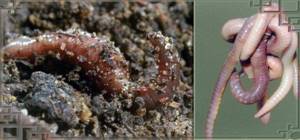
A tandem of plant and animal bait is also used, or, as it is popularly called, a “sandwich”. Live bait complements other baits well.
For example, a worm with corn perfectly attracts carp, grass carp and large bream, and adding it to pearl barley will have an effective effect on the bite of crucian carp and roach.
Collecting bait
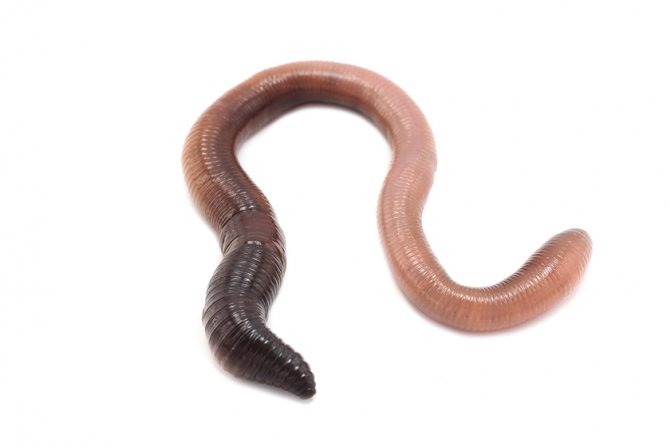
Collect crawlers in the dark using a powerful flashlight, inspecting the ground in the space between the grass. The crawler does not like grass that is too tall and dense; it is usually found in the short grasses of floodplain meadows, pastures, and abandoned vegetable gardens. The places where crawlers emerge to the surface will show holes in the soil ranging in size from 2 to 5 mm. It is worth noting that the worm is not very afraid of light, but is sensitive to sound. When collecting crawlings, try to walk on the ground quietly and not make noise.
It is even easier to collect crawlers in the city - this is usually done at night on the lawns of city parks and alleys. During heavy rains, suffocating in their burrows, the crawlers crawl out en masse to the surface of the earth, onto the asphalt and park paths. When collecting them at this time, you must definitely dry the worms (you can use paper napkins) and place them in the soil, preferably from the places where you collected them.
Storage
You can store crawlies in the lower fruit and vegetable section of the refrigerator in wooden boxes, in foam boxes, or in enamel dishes. The container should be filled with a sufficient amount of moderately moist, but not wet soil, into which you can add a little rotted foliage. Air access, of course, is required.
Once every few days it makes sense to feed the worms with a small amount of broth, a couple of pinches of cottage cheese, and add a little bran. If all conditions are met, the crawlies can live in your refrigerator for several weeks. When going fishing, the required number of worms are taken into a spacious container with soil.
Types of earthworms, habitat
The name of the earthworm traces its connection with rain. It is named so for its peculiarity of appearing on the surface of the earth during or almost immediately after rain. During floods that erode the soil, worms often end up in bodies of water, which suggests that fish are accustomed to seeing them in their environment. And many fish are simply accustomed to eating them. Collecting earthworms is very easy, since after the rains they leave their burrows en masse.
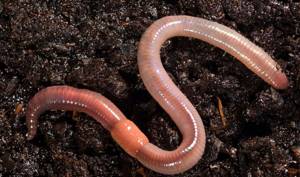
Earthworm
Preserving a crawl for fishing purposes
Having grown beautiful worms, you can go fishing. How to ensure storage of earthworms for fishing?
For short-term fishing - no more than 4-5 days - the bait can be stored in a cotton bag along with the soil. In extreme cases, a canvas mitten will do. The fabric will provide air access, and the worms will be perfectly preserved. To prevent the “escape” of crawlings, the bag must be tied. Bait packaged in this way should be stored in a cool place.
For longer fishing - up to two weeks - the crawls along with the soil should be loaded into a bucket. A five-liter bucket can comfortably store up to 300 grams of crawlies. The top of the bucket should be covered with cotton cloth and tied. Store in a cool place, avoiding direct sunlight.
River perch
He uses a sentimental spinning rod with up to 30g test and a medium spinning reel with 0.23mm main line. A drop-shaped sinker weighing 7 g is placed directly on the main line. Below it is a stop bead. The end of the main line is tied to a swivel without a carabiner, and a leash with a diameter of 0.18 mm is tied to the body of the swivel.
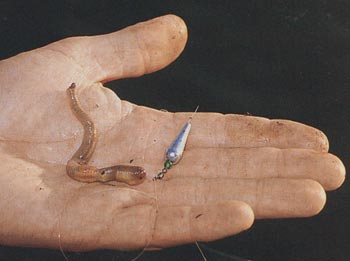
The equipment is very simple: a drop-shaped sinker, a stop bead, a 60 cm long leash with hook No. 4 and a crawler
Drowning crawl. The crawler serves as bait for us.
“Before, he always justified himself,” notes Bruno.
I'm somewhat surprised. Are we really going to catch perch on the bottom? When Bruno puts the crawler on, I notice that he is still doing something differently. Places the worm over the head on a No. 4 hook made of jewelry wire, like a twister, then slides it onto the hook all the way to the leader, the point of the hook remains independent. Approximately 2-3 cm of the worm, the back of which was previously pinched so that more “juice” flows out, hangs from the hook.
And now the first perch swallowed the crawl
Carefully, Bruno makes the first cast along the pile wall. The sinker splashes into the water and sinks to the bottom. Even in a powerful current, Bruno maintains contact with the sinker. Then he begins to twitch the sinker above the bottom. The rod rises and lowers regularly, as when fishing with a twister. Not even 5 minutes pass before the vibrating rod tip signals a bite. The fish liked the crawl.
Feeding for crawling
Did you know that coffee grounds are a kind of treat for worms? If you pour this mixture into the same place in the garden or vegetable garden, then crawlers will crawl towards it and it will not be difficult to detect them. In addition, puffballs are also attracted to oat husks. If you have birds at home and you feed them oats, then worms will definitely settle in here. With simple feedings like these, you'll always know where to find crawling worms as your choice bait for fishing.
